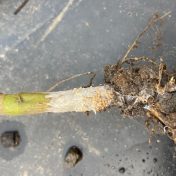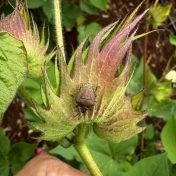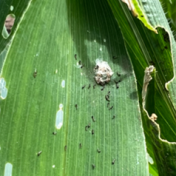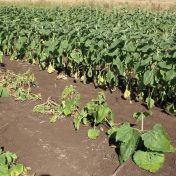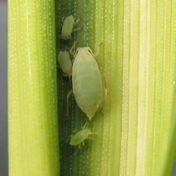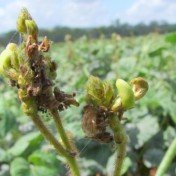Warm, wet conditions have led to isolated outbreaks of the fungal pathogen, Sclerotium rolfsii, in sorghum and grain legume crops across southern Queensland (although other regions are also at risk) and several disease outbreaks in mungbean crops growing throughout Queensland and northern New South Wales. Sclerotium rolfsii Sclerotium is a soilborne pathogen that can infect a wide range of plant… Read more »
As growers and agronomists are doing battle with fall armyworm (FAW; Spodoptera frugiperda) in maize and sorghum, another species of Spodoptera, the cluster caterpillar (Spodoptera litura; Figure 1) is causing substantial defoliation in summer pulses. We have received reports across Queensland of damaging infestations of cluster caterpillars from soybeans, mungbeans, and peanuts. A cluster caterpillar outbreak of this intensity has… Read more »
Maize and sorghum crops across Queensland are experiencing extreme fall armyworm (FAW) pressure. In Central Queensland in particular, sorghum planted in the typical planting window has been heavily impacted by the very high FAW pressure. Persistent, high-density infestations pose a risk to crops from emergence through to grain fill. In an unwelcome development not observed in previous seasons, large FAW… Read more »
High numbers of brown shield bugs (BSB, Dictyotus caenosus) have been reported in cotton fields from Hay through to Texas on the Queensland/New South Wales border. In pulse crops, these bugs (also referred to as ‘stink’ bugs) are part of the podsucking pest complex, and can cause both yield reductions and impacts to seed quality. Adults are about 8mm long… Read more »
Late sorghum is susceptible to FAW damage, and potential yield loss, in the vegetative stage. This article discusses how the yield loss happens and how to determine if your crop is at risk. The information below was generated from both sorghum trials being undertaken at the Gatton research station funded by the Queensland Government and GRDC in collaboration with QAAFI… Read more »
The DAF plant pathology team has recently identified powdery mildew and downy mildew from soybean crops growing in the Mackay region. Powdery mildew in soybean is caused by the fungus Erysiphe diffusa. This air-borne pathogen thrives in cool, humid weather. Infected plants develop symptoms initially on older leaves in the lower canopy. Whitish grey powdery patches develop on the upper… Read more »
The recent declaration of El Niño conditions for eastern Australia means an increased chance of below average rainfall. Historically, these conditions can lead to more severe outbreaks of tobacco streak virus. However, with forward planning and selection of suitable sunflower hybrids, the risk of economic impacts from TSV can be avoided. If sunflowers crops are planned for early 2024 in… Read more »
Detections of Russian wheat aphid Diuraphis noxia (RWA) in New South Wales appeared later than usual this year. RWA was detected in Tambar Springs in northern New South Wales (NSW) in August 2023, followed by detections in the Liverpool Plains, Trangie and Moree Plains. More than 60 cereal and grass samples were collected in northern NSW between April and July… Read more »
A new APVMA permit (PER 93132) allows the use of a spray drift management tool (SDMT) to re-calculate buffer zones to suit your particular situation when applying some pesticides. The SDMT (available as a spreadsheet file) and other relevant documentation (including a video on how to use the calculator) and a copy of PER93132 can be found on the APVMA… Read more »
There have been several reports of Fusarium wilt affecting mungbean paddocks throughout southern Queensland within the last couple of weeks. Monitor crops closely for disease symptoms, and contact our plant pathologist, Lisa Kelly at [email protected] or 0477 747 040 for further information on disease diagnosis. Minimise the spread of the disease by avoiding movement through infected paddocks and thoroughly removing… Read more »
